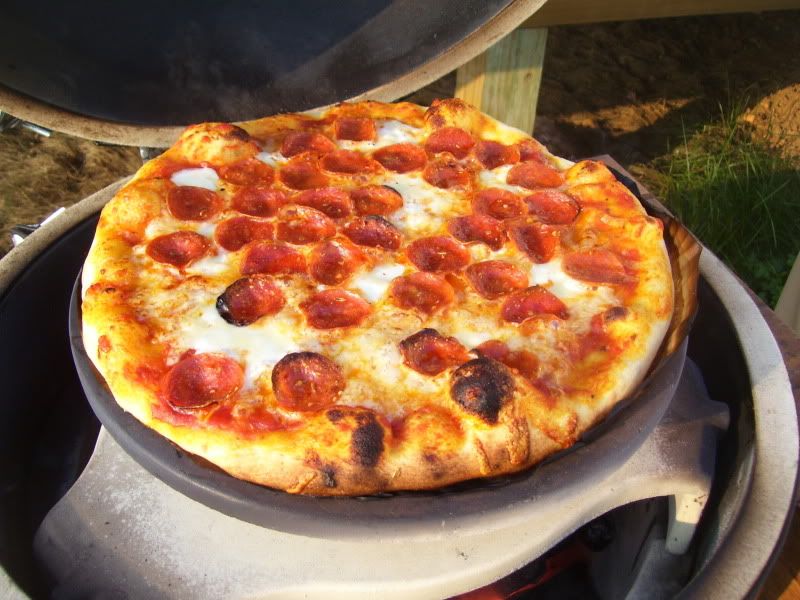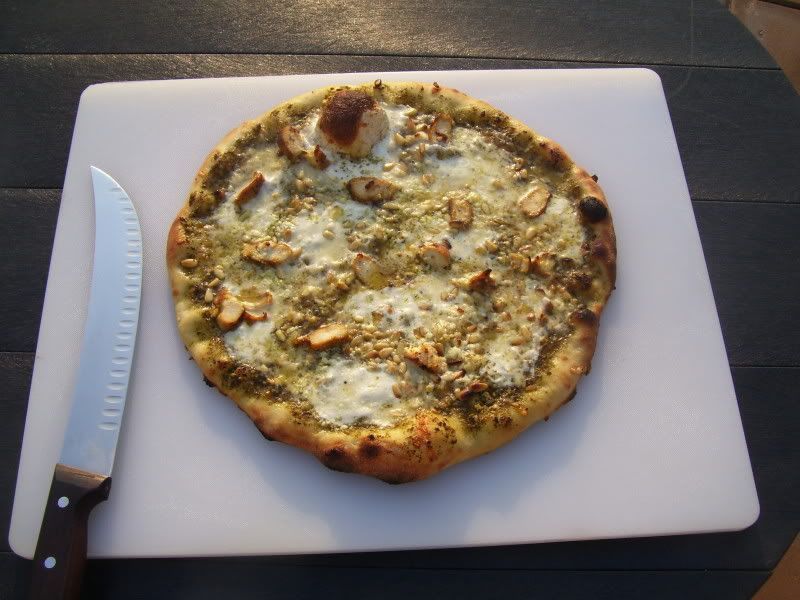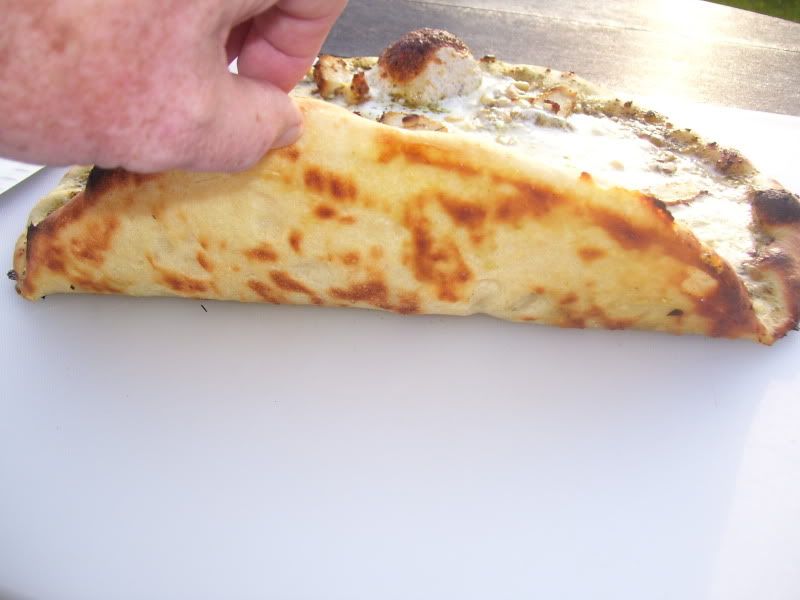Welcome to the EGGhead Forum - a great place to visit and packed with tips and EGGspert advice! You can also join the conversation and get more information and amazing kamado recipes by following Big Green Egg to Experience our World of Flavor™ at:
Want to see how the EGG is made? Click to Watch
Facebook | Twitter | Instagram | Pinterest | Youtube | Vimeo
Share your photos by tagging us and using the hashtag #BigGreenEgg.
Share your photos by tagging us and using the hashtag #BigGreenEgg.
Want to see how the EGG is made? Click to Watch
Please Fix Burned Pizza Bottoms
2cats
Posts: 34
First pie had plate setter legs down, stone on top. Circa 650. I think th gasket was burned before I ever opened the top. The pizza bottom burned. I repeated, but inserted 1.25" copper pipe elbows in between the plate setter and stone - seemed to have little effect, and the bottom was still pretty badly burned. How do I make pizzas and preserve a gasket?
Many thanks,
Joe
Many thanks,
Joe
Comments
-
Try doing the next one at 500 degrees. Your setup with the spacers was ok......temp. excessive!
-
How long are you cooking the pizza?
Are you using parchment paper or placing the pie right on the stone?
Michael -
You can also take a damp cloth and cool the stone inbetween cooks....
-
Shoulda had the elbows in from the very begging..the pizza stone was to hot....personally I don't cook pizza over 550..
-
But, but, but . . . I want to do pizzas hot. I mean, we Trex, don't we?
No parchment paper; right on the stone.
Why do we talk about a damp cloth, when we talk about how important it is to pre-heat the stone for 30 or 45 minutes before putting the pie on? Can't have it both ways.
The pizzas cooked for circa 3 or 4 minutes - I'm looking at the top the whole time. As soon as the top looks in the ball park, I open it up, and find that the bottom of the crust is burned. -
Fast and hot is THE way to cook pizza. In my opinion you can not have the egg too hot. The details however are important.
1) Must make your own dough with no sugar or oil. Store bought dough seems to burn much more easily.
2) you need to get the stone high up in the dome so that the radiant heat is more intense.
3) Must be easy on the toppings.
One you get the feel the high temp pizza is just better than the 500 degree pizza. I think it is the same idea with the TREX steak in hat it takes some time to learn but once you do its worth learning.
I try to keep my egg at about 700 when I cook pizza. -
I cook successfully at 700, with 1 1/4" copper couplings providing space between the plate setter and the stone. I never really toasted my original gasket, but it was getting brittle, so I installed one of the new Nomex(R)gaskets.
IMHO, if you want to cook that hot, you need to use a homemade dough with 60-65% hydration.
I am going to go back to 600-650 next time, just because it works and it is easier not to overcook the pizza.
Here was my last effort



-
I normally cook zah around 550 dome, but I've heard a lot of people cooking it higher. (lid down by the way)
I tried some corn meal on the stone followed by the zah and it burned almost immediately - giving the crust a burnt taste.
I then decided to use parchment paper and it worked fine.
One thing I do wonder about is how long the stone is heating up before you put the pie on. (ie: if the dome temp says 650, and it's been sitting there for a while, what's the temp of the stone?)
I don't really know the answers for you, one thing though, I don't think I'd ever wipe the stone with a damp cloth between pies. IU think that would be a fast frop in temp - I'd be afraid the stone would crack.
Try the parchment - maybe it will work for you
Good luck!
Michael -
Thosre are some nice pies.
Do you have a dough recipe?
Michael -
Here is what I am using.
Pizza Dough with Jeff Varasano’s Kneading Techniques
The brown sugar helps the crust brown on the pizza stone.
3 cups bread flour (480 grams or 16.9 ounces)
1 cup semolina flour (160 grams or 5.6 ounces)
Note: Jeff says even regular flour for the whole amount is okay.
1 packet instant yeast (**)
1 tsp. salt (2 tsp if using Kosher salt)
1 Tbsp. brown sugar
1 ¾ C warm water (414 grams or 14.6 ounces)
2 Tbsp veg oil.
Comments:
NOTE: This recipe makes a dough with 65% hydration. I think it is a little wet, especially with a long slow rise, so am planning to cut back to 60% next time (384 grams or 13 ounces).
Everything should be room temperature or a bit cooler.
Mix all the liquids plus the sugar in the bowl of your mixer.
Mix dry ingredients. Add ¾ of the dry ingredients to the mixer bowl. Mix on lowest speed for 1-2 minutes or until completely blended (I use the paddle for this stage). At this stage you should have a mix that is drier than a batter, but wetter than a dough.
Cover and let it rest for 20 minutes.
The high moisture initiates a process called autolyse, which activates the gluten in the flour. This is the same technique used in the no knead bread recipe.
After the rest (don’t rush this and not harm letting it go longer), start mixing on low speed for 5 minutes – do not add remaining flour during this time (using paddle). Five minutes into the kneading, switch to the dough hook and start adding flour gradually and let it come together to a smooth dough.
At this point I divide the dough into two pieces and set it aside for the rise. This is perfect for two pizzas on the BGE pizza stone.
(**) If you are going to use on the day you make the dough, add the yeast as shown above. If you want to let the dough develop for one or more days in your refrigerator, cut back to ¼ - ½ teaspoon yeast.
This comes together with a single rise to 1 ½ - 2 times original size.
You should press/stretch the dough with your hands. Rolling the dough will collapse the air bubbles and you will get a less effective rise when you cook the pizza. On the other hand a rolled crust will be more like a cracker type crust.
Cornmeal version: replace ¾ cup (120 grams) flour with ¾ cup cornmeal. This tasted really good and I need to work with it again!
I always cook mine on parchment – even when cooking at 700! For me the dough is easier to handle and you can press out the dough, ahead of time, on the parchment rounds. -
I didn't say you couldn't do them hot....but with the stone sitting right on the platesetter and your dome reading 700 ish....your platesetter AND stone were probaly close to 1100 to 1200 degrees...thats why I said you should have used the elbows from the begining and your pizza stone would have been more realistically in the 700 degree range..while the PS would have been absorbing the brunt of the inferno from below..
-
Exactly what WessB said. You need a space between the plate setter and the pizza stone for example: the little green Egg feet on the plate setter then the stone, Stone on the grid or stone on a raised grid. As long as you have that space you can cook them as hot as you like.
-
Thank you - i will give it a try.
Michael -
With the plate setter legs down, and the aforementioned inferno below...all of that extreme heat will be hitting the platesetter ( at felt level I believe you mentioned ) and sending it outward towards the egg shell( right at gasket level ) before allowing it to rise into the dome....hence...FRIED gaskets...not saying this is a rule...but it sure makes sense to me..if you want to cook at 700 degrees, be patient in getting up to temp..even my 550 degree pizzas I take a good 60 to 90 minutes to get there and stabalize everything...
-
Bobs has hit on the key. If you are trying to replicate a Neapolitan style Pizza you need dough with a high hydration. This allows the dough to withstand high heat and also gives the desired effect of rapidly expanding steam inside the CO2 bubbles in the dough.
I have never used a premade crust but I think they may be to dry for high temps.
If you live in an area where you can get Pizza cooked at high temps (i.e. a Neapolitan, VPN or New York style) and are trying to replicate it I suggest you search Neapolitan on this forum as there are a lot of people doing this here.
TTFN WLL -
2 cats I use a spacer between the stone and platesetter. Also we have found that when we do higher temp pizza cooking you have to make thinner pizza with few toppings, otherwise your crust will burn before the top is done. I usually have trouble with restraint and toppings so I have to cook my thicker pies at a lower temp 500 to 525 range. My wife however has mastered the thin crispy pizza crust. I do not know if this matters but just before we put the pie on I sprinkle corn meal on the stone. good luck
-
What type of pizza are you trying to make?
Neopolitan = high heat up to 1200 deg and high hydration (60%+) great crunch but a little chew 3-4 min cook, qood taper to a thin middle
NY style = med high heat around 550-600 thinner chewy crust but with a nice biit of crunch (50%-60%) 15+ min cook, good taper to the center
American sytle = 500 deg thinner crust but soft in the middle. Little chew and some crunch kinda bread like (40%-50%) around 30 min cook, moderate taper
Thin = 350-450 depending on hydration cook time depends on hydration, no taper
Chicago = deepdish...nuff said
Thick style= 400 deg thick crust no taper, more bread like...
The point to all this is that you have to know what type you want before people can give you advice. -
I used the Lehmann recipe targetting 63% - and it did have 1% oil. No sugar, though.
However, as it was my first dough, I added both a little unmeasured flour and water. I did weigh my final dough to see the extent of deviation. If everything I added was water, the hydration would have been 67%. If it had all been flour, 61%. I would contend that my hydration was in range.
I did use cornmeal - on the wooden peel, and it was enough so that the pizza never stuck. I felt that the burning bottoms looks more homogeneous than burned cornmeal would look; here are the two pies:

Having said all that, here is the stone after the first cook:
Also, note that the first one was stone on plate setter, and the second utilized the 1.25" pipe spacers. Not much improvement. How effective would parchment paper be to solve the burning problem? Would it be adequate to omit corn meal, and substitute parchment?
What about this: plate setter, legs up; grid; BGE single level grid extender; stone? This would have nothing at gasket level to deflect heat and flame onto the gasket, and raise the pie higher in the dome. Would this do the trick? -
Any takers on the questions above?
When using parchment paper, do you also/still use some cornmeal or flour in between the parchment paper and the dough?
What do people think about the arrangement which has only the grill at gasket height, by using the plate setter legs up, followed by the grill, and raising the stone with the single level grid extender?
I intend to go commando (only the burnt remnants of my original gasket) until I feel a pressing need for a gasket. -
2cats wrote:Also, note that the first one was stone on plate setter, and the second utilized the 1.25" pipe spacers. Not much improvement. How effective would parchment paper be to solve the burning problem? Would it be adequate to omit corn meal, and substitute parchment?
What about this: plate setter, legs up; grid; BGE single level grid extender; stone? This would have nothing at gasket level to deflect heat and flame onto the gasket, and raise the pie higher in the dome. Would this do the trick?
The parchment paper will not keep it from getting burnt. If you are usnig the parchment paper there is no need for the corn meal. As for your last question, That set up would do fine that is what I have been using as of late. -
2cats wrote:
There is no need to use anything on the parchment paper. If you are using parchment paper just build the pizza on the paper and slide paper and pizza on to the stone. Don't forget to trim excess paper.When using parchment paper, do you also/still use some cornmeal or flour in between the parchment paper and the dough? -
Well, if the parchment paper won't prevent it from getting burned, I'll just stick with the cornmeal. What temperatures do you use with the stone-on-the-grid-extender, plate-setter-legs-up arrangement, and how does this impact the balance of top and bottom cooking, and how does it treat the gasket?
-
your pie looks like it had some sauce that made it under the dough, maybe spillage or it soaked thru from not making it fast enough and getting it on the egg quick enough. happens to me sometimes when im going veru this, and used to happen to me when first starting out with pizzas. the higher in temp you go the more mass you need under the pie and the thinner the pie needs to be. thick pies low heat, thin thin pies high heat. hers my setup for very thin pies at nuclear temps and you will see lots of mass under the stone and no burning. i use onl a tablspoon or two for the sauce now as the really thin pies soak thru to quicly if there is too much sauce
http://www.eggheadforum.com/index.php?option=com_simpleboard&Itemid=55&func=view&catid=1&id=411252fukahwee maineyou can lead a fish to water but you can not make him drink it
Categories
- All Categories
- 184K EggHead Forum
- 16.1K Forum List
- 461 EGGtoberfest
- 1.9K Forum Feedback
- 10.5K Off Topic
- 2.4K EGG Table Forum
- 1 Rules & Disclaimer
- 9.2K Cookbook
- 15 Valentines Day
- 118 Holiday Recipes
- 348 Appetizers
- 521 Baking
- 2.5K Beef
- 90 Desserts
- 167 Lamb
- 2.4K Pork
- 1.5K Poultry
- 33 Salads and Dressings
- 322 Sauces, Rubs, Marinades
- 548 Seafood
- 175 Sides
- 122 Soups, Stews, Chilis
- 40 Vegetarian
- 103 Vegetables
- 315 Health
- 293 Weight Loss Forum

